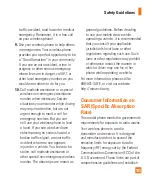
131
Safety Guidelines
traffic accident, road hazard or medical
emergency. Remember, it is a free call
on your wireless phone!
9.
Use your wireless phone to help others
in emergencies. Your wireless phone
provides you a perfect opportunity to be
a “Good Samaritan” in your community.
If you see an auto accident, crime in
progress or other serious emergency
where lives are in danger, call 911 or
other local emergency number, as you
would want others to do for you.
10.
Call roadside assistance or a special
wireless non-emergency assistance
number when necessary. Certain
situations you encounter while driving
may require attention, but are not
urgent enough to merit a call for
emergency services. But you can
still use your wireless phone to lend
a hand. If you see a broken-down
vehicle posing no serious hazard, a
broken traffic signal, a minor traffic
accident where no one appears
injured or a vehicle. You know to be
stolen, call roadside assistance or
other special non-emergency wireless
number. The above tips are meant as
general guidelines. Before deciding
to use your mobile device while
operating a vehicle, it is recommended
that you consult your applicable
jurisdiction’s local laws or other
regulations regarding such use. Such
laws or other regulations may prohibit
or otherwise restrict the manner in
which a driver may use his or her
phone while operating a vehicle.
For more information, please call to
888-901-SAFE, or visit our website
http://www.ctia.org.
Consumer Information on
SAR (Specific Absorption
Rate)
This model phone meets the government’s
requirements for exposure to radio waves.
Your wireless phone is a radio
transmitter and receiver. It is designed
and manufactured not to exceed the
emission limits for exposure to radio
frequency (RF) energy set by the Federal
Communications Commission (FCC) of the
U.S. Government. These limits are part of
comprehensive guidelines and establish





































